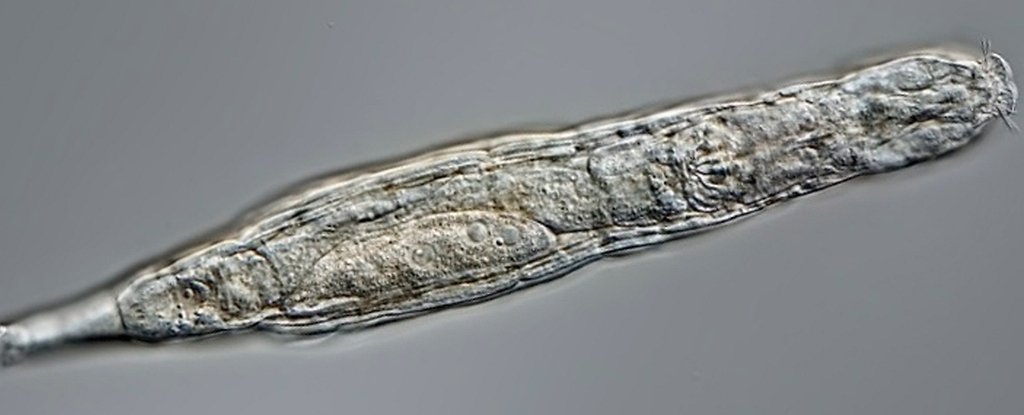
Posted on 06/07/2021 8:54:58 AM PDT by Red Badger

One of the revived rotifers. (Michael Plewka)
For tens of thousands of years, a microscopic creature lay frozen and immobile underground in the Siberian permafrost.
Yet, when scientists thawed it out, the tiny multicellular animal didn't just revive - it reproduced, suggesting that there is a mechanism whereby multicellular animals can avoid cell damage during the freezing process and wake up ready to rumble.
"Our report is the hardest proof as of today that multicellular animals could withstand tens of thousands of years in cryptobiosis, the state of almost completely arrested metabolism," said biologist Stas Malavin of the Soil Cryology Laboratory at the Institute of Physicochemical and Biological Problems in Soil Science in Russia.
The creature is one that is known today - a microscopic invertebrate called a rotifer. These tiny aquatic beasties live in bodies of water around the world, and their ability to survive conditions such as freezing and dehydration is fascinating.
Previous studies and experiments showed that they can survive for years in a state of cryptobiosis, in which the body hits pause on all biological functions - suspended animation, if you like. For a frozen state, we knew that they could survive for a decade.
The ancient Arctic permafrost has been an unexpectedly rich trove of ancient organisms that have survived millennia. These have included microbes such as viruses, as well as plants and moss. One exceptional recovery was a multicellular nematode, from permafrost older than 30,000 years.
The recovery of the rotifer, a freshwater species of the genus Adineta, suggests that the nematode's recovery wasn't just a wild fluke. The permafrost sample was collected from 3.5 meters (11.5 feet) below ground at the Alazeya River in Northern Siberia. It contained ice-rich loam from the Late Pleistocene; radiocarbon dating confirmed that the sample was around 24,000 years old.
The researchers maintained cultures from this sample, which contained a range of organisms - including a number of living rotifers. While in the lab, these tiny creatures reproduced by means of parthenogenesis; that is, asexual cloning, the only way rotifers can reproduce.
Their presence in the frozen sample - as opposed to contamination - was confirmed by looking for genetic material in the permafrost and comparing the ancient rotifers to modern species.
Then, the research team randomly selected 144 individuals of the revived strain and froze them again at a temperature of -15 degrees Celsius for a period of one week. The survivors were compared to frozen and revived members of contemporary freshwater rotifers. Fascinatingly, the ancient rotifers didn't seem to be significantly more freeze-resistant than modern rotifers.
The team's analysis suggests that, if the freezing process is relatively slow, the rotifers' cells can survive the formation of ice crystals with minimal damage, allowing them to survive - although how they can survive for tens of thousands of years is still unknown.
The team hopes to conduct further research into the process in the hopes of identifying the mechanism. This could then - with a very big maybe - help identify a way to protect the cells of more complex organisms, the researchers said.
"The takeaway is that a multicellular organism can be frozen and stored as such for thousands of years and then return back to life - a dream of many fiction writers," Malavin said.
"Of course, the more complex the organism, the trickier it is to preserve it alive frozen and, for mammals, it's not currently possible. Yet, moving from a single-celled organism to an organism with a gut and brain, though microscopic, is a big step forward."
The research has been published in Current Biology.
I don't know if that's good or bad, but it is usually bad for quality when a conglomerate owns you.
bruh...
They did it in a movie “Smila’s Sense of Snow”. Good movie, Julia Ormond was beyond hot!
Yes, I saw that movie!.......................
I once did this experiment with a lizard. Put the lizard in the freezer for two hours to see if when thawed the lizard is alive. The answer was yes, until the cat ate him.
Oh what a good idea. I’m sure absolutely nothing could go wrong with this experiment. The government is in charge so what could go wrong?
Seeded from Space, like everything else in the Universe, which is nothing less than a perpetual recylcing system.
https://www.panspermia.org/intro.htm
quote:
Starting in the 1970s, British astronomers Fred Hoyle and Chandra Wickramasinghe rekindled interest in panspermia. By careful spectroscopic observation and analysis of light from distant stars they found new evidence, traces of life, in the intervening dust. They also proposed that comets, which are largely made of water-ice, carry bacterial life across galaxies and protect it from radiation damage along the way. One aspect of this research program, that interstellar dust and comets contain organic compounds, has been pursued by others as well. It is now widely accepted that space contains the “ingredients” of life. This development could be the first hint of a huge paradigm shift. But mainstream science has not accepted the hard core of modern panspermia, that whole cells seeded life on Earth.
I agree with the panspermia approach to the distribution of life throughout the galaxy.
Love to see what has arisen elsewhere , but the chances of having sentient life existing at the same time in the galaxy is very small.They rise , dwell and die in cycles that do not necessari;y match each other.
But their seed?
It appears to be quite profoundly present throughout.

I read this in the eighties...
Thanks for the reference!
Thx, will ping later.
Disclaimer: Opinions posted on Free Republic are those of the individual posters and do not necessarily represent the opinion of Free Republic or its management. All materials posted herein are protected by copyright law and the exemption for fair use of copyrighted works.